To defeat the weeds infesting your lawn, it is important to know what kind of weeds you have to be more effective at dealing with them.
The simplest, easiest, and most effective way to keep those pesky weeds from taking over is to keep a thick and healthy lawn.
Thick and healthy grass can be attained with:
- annual overseeding
- seasonal fertilizing
- sufficient watering amounts
- regular grass cutting at the right height
- using a mower with sharp blades
By keeping the grass thick and healthy, only a few weeds will be able to invade your lawn.
And when the odd one does pop up, you can simply pull it out to prevent further spreading of the root system.
Not only is that a highly effective way to get rid of them, but it is also the most eco-friendly way to deal with weeds.
Be sure to walk your property with the following list to discover just how many of these stubborn plants are infiltrating your yard and inhibiting the lushness of your lawn.

1. Crabgrass
This is an annual weed reproducing by seed. It has branching, and spreading stems.
Its coarse, blue-green to purplish leaf blades can be smooth or hairy, depending on the species.
Both varieties have tapered leaf blades. The base of the clump has several fingerlike spikes rising from narrow stems.
Keeping your lawn thick and healthy, as well as free of bare spots, is the best way to prevent crabgrass.
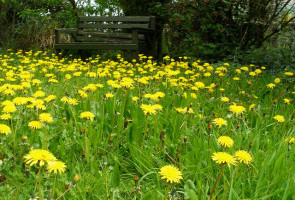
2. Dandelion
Well, I think almost everyone knows what this weed looks like!
It’s a perennial that is part of the Aster family. It is well known for its bright-yellow flowers and large leaves rising from a long, deeply penetrating taproot.
They reproduce by producing a round, white, globe-shaped seed head. Dandelions favour thin turf and will flower from early Spring until late Fall.
You can make a simple homemade weed killer to treat them.
Mix 1 gallon of white vinegar + 1/4 cup salt +1/2 liquid dish soap. Pour the mixture into a spray bottle. Do your best to only spray the dandelion so as not to kill grass or plants nearby. The dandelion should wilt by the next day.
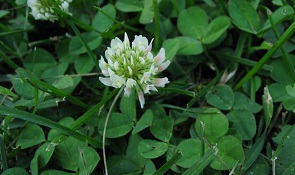
3. White Clover
This is a perennial that used to be part of grass seed mixes.
Also called White Dutch Clover its leaves are distinguished by three lobes with a crescent-shaped white band.
It spreads by creeping stems and does well in sparse, undernourished turf with too much moisture.
Control it by feeding your lawn nitrogen fertilizer and avoiding excessive applications of phosphorus.

4. Ground Ivy
This weed is also commonly known as Creeping Charlie.
It’s part of the broadleaf perennial variety and falls in with the mint family.
It features square stems with bright green, rounded scalloped-edged leaves.
This weed reproduces by seed as well as having creeping stems that root as they touch the ground.
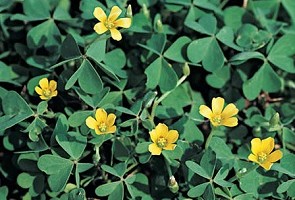
5. Yellow Wood Sorrel
Also known as Sour Clover and Oxalis.
This is a broadleaf perennial, even though it might act as an annual in some regions.
It shows clover-shaped leaves and yellow flowers – each with five uniformly shaped petals.
This plant spreads by roots and seeds.
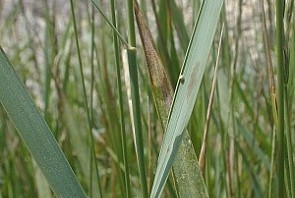
6. Quackgrass
This weed will often be mistaken for Crabgrass.
It’s a perennial with flat light-green to blue-green leaves which are flat and nearly smooth on top. The under part of the leaf sheaths are hairy.
At the top, you will find spikelets alternating from one side of the central stalk to the other.
Each spikelet is made up of 3 to 7 florets. It spreads by seeds and aggressive rhizomes (underground stems).
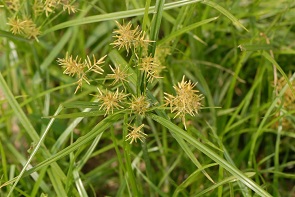
7. Yellow Nutsedge
This is also known as Nut Grass and Ground Almond.
It’s a grassy perennial sedge with triangular stems and numerous slender leaves near the base of the plant. However, it is sparse near the top except for a cluster at the base of the umbrella-like cluster of yellowish spikelets.
Preventing this weed from establishing itself is the best plan.
This weed reproduces by seed, tubers, and rhizomes that grow at the root tips. Tubers often persist in the soil, making established plants difficult to control.
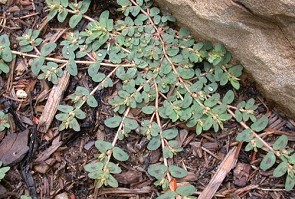
8. Spotted Spurge
This low-growing weed likes to keep close to the ground.
As an annual weed, it reproduces by seed and it will create a fast-spreading mat along the ground.
The leaves on this plant are small, rounded, and green with a reddish-brown or purplish spot on top. When the stems are cut they exude a milky liquid.
Learn More About Weeds in Ontario
To see the full gallery of weeds commonly found in Ontario, visit the Ontario Provincial Government site here.
There they list hundreds more weed varieties that can help you to identify the weeds popping up around your property!
If you have a lawn with a lot of weeds, you should consider getting your grass professionally treated and also include a protocol for overseeding and regular fertilizing.
For professional weed treatment, we recommend that you contact a local Muskoka weed company to create a regular weed treatment schedule for your property.
If the number of weeds in your lawn are more than the amount of good turf left (like in the picture below) consider having it all removed and replacing it with new sod.
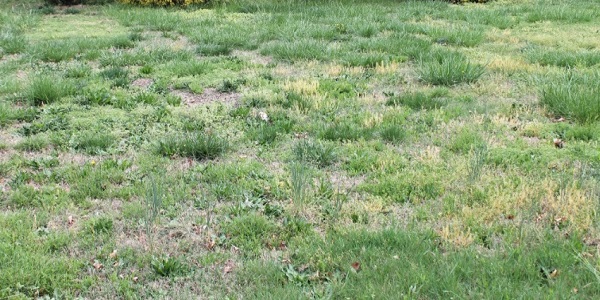
Choosing to have a weed-infested lawn removed and replaced with new sod installed will make your yard look like this in no time:

In just a day or two, your yard can look fresh and tidy with a new weed-free lawn.
Need your grass to be properly cut? Call us if your property is in or near the Bracebridge area of Muskoka.
We can set up a fast & friendly visit to help you decide the next step.
Call: 705-644-1653
